英语第七讲
- 格式:ppt
- 大小:290.00 KB
- 文档页数:12
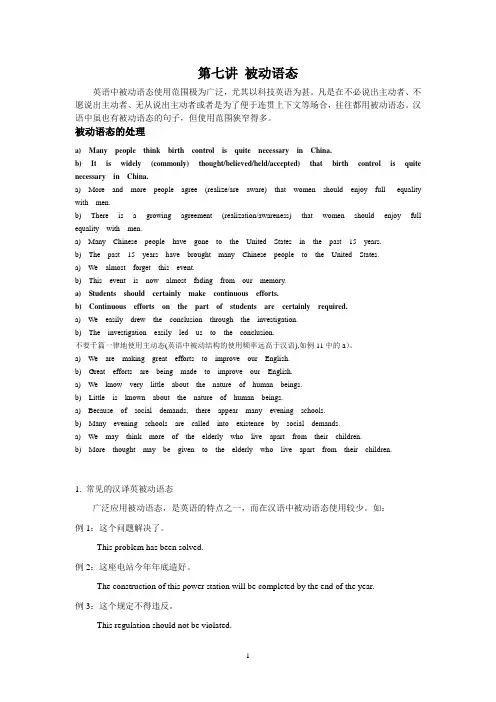
第七讲被动语态英语中被动语态使用范围极为广泛,尤其以科技英语为甚。
凡是在不必说出主动者、不愿说出主动者、无从说出主动者或者是为了便于连贯上下文等场合,往往都用被动语态。
汉语中虽也有被动语态的句子,但使用范围狭窄得多。
被动语态的处理a)Many people think birth control is quite necessary in China.b)It is widely(commonly)thought/believed/held/accepted)that birth control is quite necessary in China.a)More and more people agree(realize/are aware)that women should enjoy full equality with men.b)There is a growing agreement(realization/awareness)that women should enjoy full equality with men.a)Many Chinese people have gone to the United States in the past15years.b)The past15years have brought many Chinese people to the United States.a)We almost forget this event.b)This event is now almost fading from our memory.a)Students should certainly make continuous efforts.b)Continuous efforts on the part of students are certainly required.a)We easily drew the conclusion through the investigation.b)The investigation easily led us to the conclusion.不要千篇一律地使用主动态(英语中被动结构的使用频率远高于汉语),如例11中的a)。

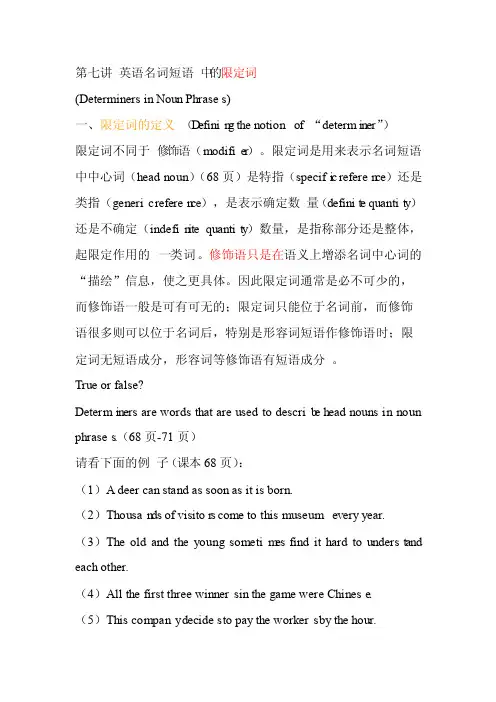
第七讲英语名词短语中的限定词(Determi ners in Noun Phrases)一、限定词的定义(D efinin g the notionof “determiner”)限定词不同于修饰语(modifie r)。
限定词是用来表示名词短语中中心词(head noun)(68页)是特指(specifi c referen ce)还是类指(generic referen ce),是表示确定数量(definit e quantit y)还是不确定(indefin ite quantit y)数量,是指称部分还是整体,起限定作用的一类词。
修饰语只是在语义上增添名词中心词的“描绘”信息,使之更具体。
因此限定词通常是必不可少的,而修饰语一般是可有可无的;限定词只能位于名词前,而修饰语很多则可以位于名词后,特别是形容词短语作修饰语时;限定词无短语成分,形容词等修饰语有短语成分。
True or false?Determiners are words that are used to describ e head nouns in noun phrases.(68页-71页)请看下面的例子(课本68页):(1)A deer can stand as soon as it is born.(2)Thousan ds of visitor s come to this museumevery year.(3)The old and the young sometim es find it hard to underst and each other.(4)All the first three winners in the game were Chinese.(5)This company decides to pay the workers by the hour.(6)Come and see us whenever you have any time.(7)To tell you the truth, I do not like either color very much. (8)I have to read all these books for my course.请说出上面各句中的名词短语有哪些,注意其中的限定词。
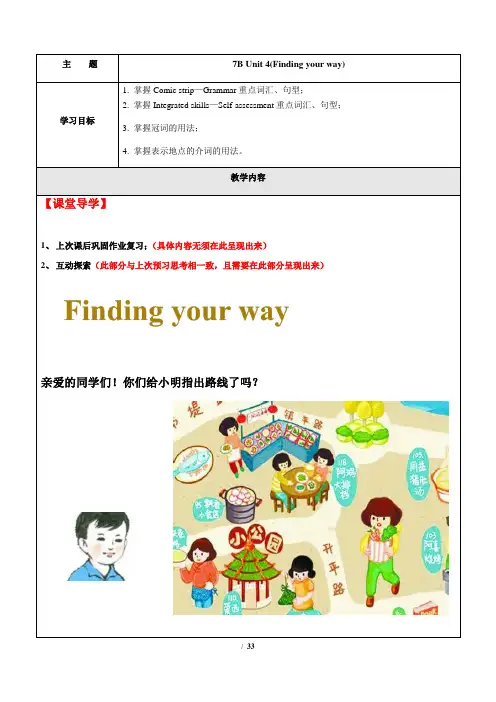
主题7B Unit 4(Finding your way) 学习目标1. 掌握Comic strip—Grammar重点词汇、句型;2. 掌握Integrated skills—Self-assessment重点词汇、句型;3. 掌握冠词的用法;4. 掌握表示地点的介词的用法。
教学内容【课堂导学】1、上次课后巩固作业复习;(具体内容无须在此呈现出来)2、互动探索(此部分与上次预习思考相一致,且需要在此部分呈现出来)亲爱的同学们!你们给小明指出路线了吗?First, go straight on and turn right at the park.Next, walk along the Shengping Road and then turn left at the first turning.At last, you will see the barbecue bar at the end of the road.must “必须”,没有人称、数、时态的变化,否定式mustn ’t 表示“禁止” 表示说话人主观上的看法,强调主观上的需要【知识梳理5】Sunshine Zoo is north of Sunshine Middle School. 阳光动物园在阳光中学的北部。
(1) north 名词,意为 ,固定结构为 ,表示 。
指范围之外,且中间有一段距离。
(2) 方位名词与介词in, on, to 连用时的区别含义 用法 in+方位名词在……之内 强调 on+方位名词在……之外 强调 to+方位名词在……之外 强调 【例题精讲】1. The tree is in the north of the school.2. The hill is on the north of the school.3. The cinema is to the north of the school.答案:(1) north 名词,意为“北,北方”,固定结构为be+方位词+of ……,表示“某地在另一地的……方向”。
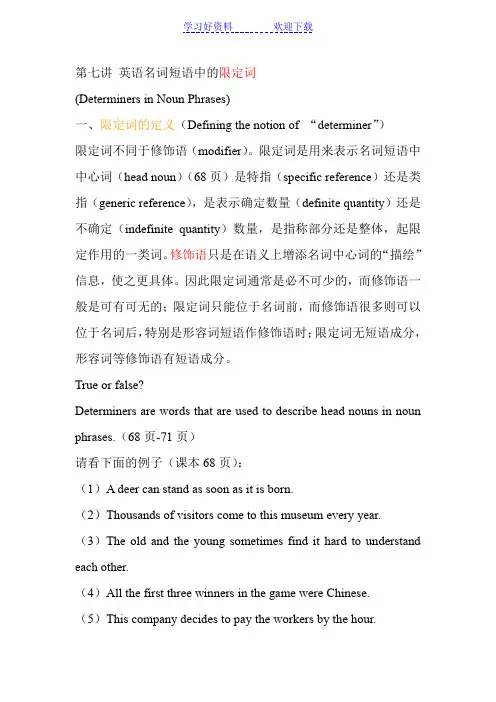
第七讲英语名词短语中的限定词(Determiners in Noun Phrases)一、限定词的定义(Defining the notion of “determiner”)限定词不同于修饰语(modifier)。
限定词是用来表示名词短语中中心词(head noun)(68页)是特指(specific reference)还是类指(generic reference),是表示确定数量(definite quantity)还是不确定(indefinite quantity)数量,是指称部分还是整体,起限定作用的一类词。
修饰语只是在语义上增添名词中心词的“描绘”信息,使之更具体。
因此限定词通常是必不可少的,而修饰语一般是可有可无的;限定词只能位于名词前,而修饰语很多则可以位于名词后,特别是形容词短语作修饰语时;限定词无短语成分,形容词等修饰语有短语成分。
True or false?Determiners are words that are used to describe head nouns in noun phrases.(68页-71页)请看下面的例子(课本68页):(1)A deer can stand as soon as it is born.(2)Thousands of visitors come to this museum every year.(3)The old and the young sometimes find it hard to understand each other.(4)All the first three winners in the game were Chinese.(5)This company decides to pay the workers by the hour.(6)Come and see us whenever you have any time.(7)To tell you the truth, I do not like either color very much. (8)I have to read all these books for my course.请说出上面各句中的名词短语有哪些,注意其中的限定词。
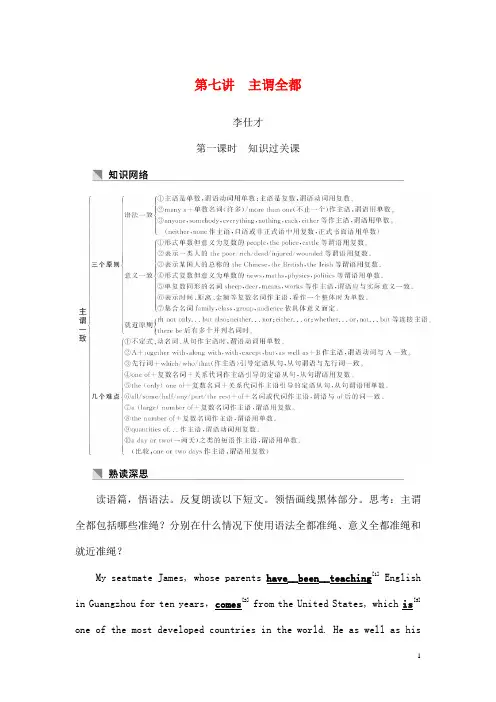
第七讲主谓全都李仕才第一课时知识过关课读语篇,悟语法。
反复朗读以下短文。
领悟画线黑体部分。
思考:主谓全都包括哪些准绳?分别在什么情况下使用语法全都准绳、意义全都准绳和就近准绳?My seatmate James, whose parents have__been__teaching[1] English in Guangzhou for ten years,comes[2]from the United States, which is[3] one of the most developed countries in the world. He as well as hisparents enjoys[4] living in Guangzhou because neither James nor his parents find[5] it difficult to adapt to the life in China. In their opinion, many a custom here is[6] easy to understand and ten years is[7] enough for them to get used to all the customs.I, together with James, extremelylike[8]English but physics seems[9]rather difficult for us. Besides,both he and I are[10]very fond of reading story books, and the Arabian Nights is[11]one of the most interesting books that have__been__read[12] by us. Our class is[13] united as a big family. Now the class are[14]preparing for the coming sports meet, so large quantities of our recent time have__been__spent[15]on it. What we need is[16] a qualified coach because being trained properly is[17] of great importance. We each are all aware that each of us plays[18]an important role in our class. We have decided to hold a celebration if getting a good result but when and where we are going to hold it hasn’t__been__decided[19].1.语法全都准绳,复数主语用复数谓语动词。
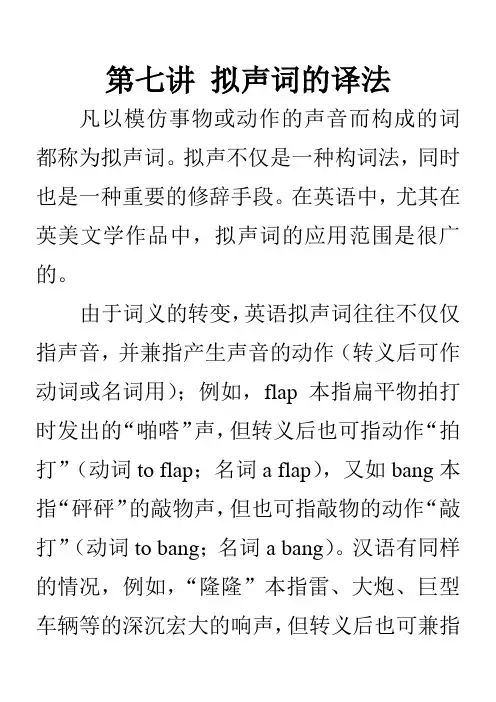
第七讲拟声词的译法凡以模仿事物或动作的声音而构成的词都称为拟声词。
拟声不仅是一种构词法,同时也是一种重要的修辞手段。
在英语中,尤其在英美文学作品中,拟声词的应用范围是很广的。
由于词义的转变,英语拟声词往往不仅仅指声音,并兼指产生声音的动作(转义后可作动词或名词用);例如,flap本指扁平物拍打时发出的“啪嗒”声,但转义后也可指动作“拍打”(动词to flap;名词a flap),又如bang本指“砰砰”的敲物声,但也可指敲物的动作“敲打”(动词to bang;名词a bang)。
汉语有同样的情况,例如,“隆隆”本指雷、大炮、巨型车辆等的深沉宏大的响声,但转义后也可兼指“打雷”、“炮轰”、“行车”等动作(作动词或名词用)。
拟声词的翻译可归纳为三种情况:一、英语原文有拟声词,汉译时也运用拟声词(一)英语拟声词同感叹词一样,独立使用,不作为所在句中的任何句法成分。
汉语拟声词有同样的情况,因此汉译时较简便,把英语原文中作独立成分用的拟声词相应地译成汉语中作独立成分用的拟声词即可。
例如:1)Two heavy guns went off in the woods --- BRUMP! BRUMP!两门重炮在森林里开始发射了---轰隆!轰隆!2) Thump! A table was overturned!“哗啦!”桌子推翻了。
(二)英语拟声词大多作动词、名词或动词派生词(如分词、不定式、动名词)等使用,而汉语中的拟声词则大多是动词附加语或名词附加语,如“枪声砰砰地响着”中的“怦怦地”是动词附加语,“我们听到了砰砰的枪声”中的“砰砰的”是名词附加语。
因此,英译汉时往往可把原文中的英语拟声动词、拟声名词或拟声动词派生词转译成汉语拟声动词附加语或名词附加语。
例如:1) But as the door banged, she seemed to come to life again.可是当门砰地关上的时候,她好像又清醒过来了。
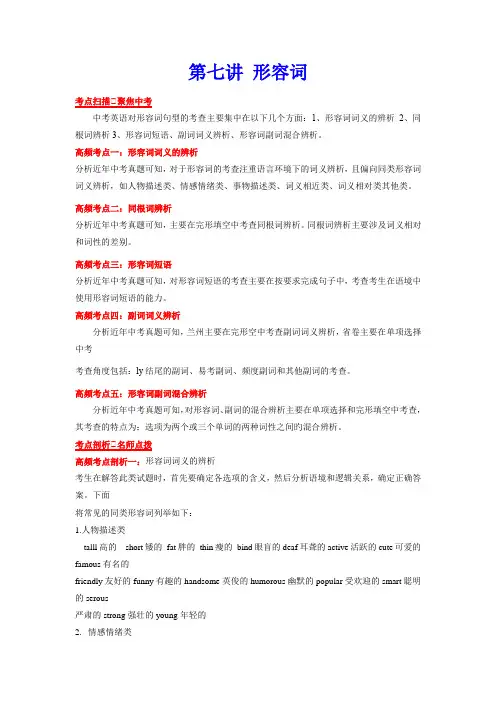
第七讲形容词考点扫描☆聚焦中考中考英语对形容词句型的考查主要集中在以下几个方面:1、形容词词义的辨析2、同根词辨析3、形容词短语、副词词义辨析、形容词副词混合辨析。
高频考点一:形容词词义的辨析分析近年中考真题可知,对于形容词的考査注重语言环境下的词义辨析,且偏向同类形容词词义辨析,如人物描述类、情感情绪类、事物描述类、词义相近类、词义相对类其他类。
高频考点二:同根词辨析分析近年中考真题可知,主要在完形填空中考查同根词辨析。
同根词辨析主要涉及词义相对和词性的差别。
高频考点三:形容词短语分析近年中考真题可知,对形容词短语的考查主要在按要求完成句子中,考查考生在语境中使用形容词短语的能力。
高频考点四:副词词义辨析分析近年中考真题可知,兰州主要在完形空中考查副词词义辨析,省卷主要在单项选择中考考查角度包括:ly结尾的副词、易考副词、频度副词和其他副词的考查。
高频考点五:形容词副词混合辨析分析近年中考真题可知,对形容词、副词的混合辨析主要在单项选择和完形填空中考查,其考查的特点为:选项为两个或三个单词的两种词性之间旳混合辨析。
考点剖析☆名师点拨高频考点剖析一:形容词词义的辨析考生在解答此类试题时,首先要确定各选项的含义,然后分析语境和逻辑关系,确定正确答案。
下面将常见的同类形容词列举如下:1.人物描述类talll高的short矮的fat胖的thin瘦的bind眼盲的deaf耳聋的active活跃的cute可爱的famous有名的friendly友好的funny有趣的handsome英俊的humorous幽默的popular受欢迎的smart聪明的serous严肃的strong强壮的young年轻的2.情感情绪类bored无聊的disappointed失望的excited兴奋的frightened害怕的happy开心的interested感兴趣的lonely孤独的nervous焦虑的;紧张的proud骄傲的,自豪的sad伤心的surprised惊讶的3.事物描述类worried担忧的available可利用的bad坏的boring无聊的different不同的fantastic极好的popular流行的special特别的useful有用的4.词义相近类Expensive与high:描述物品贵用expensive,描述物品价格(price)高用high;loney与alone描指述人感到孤独的用lonely(可作定语、表语和宾语补足语),描述人独自的用alone③sleepy与asleep:描述人瞌睡的用sleepy(作表语或前置定语),描述人睡着的状态用asleep(作表语或宾语补足语)。


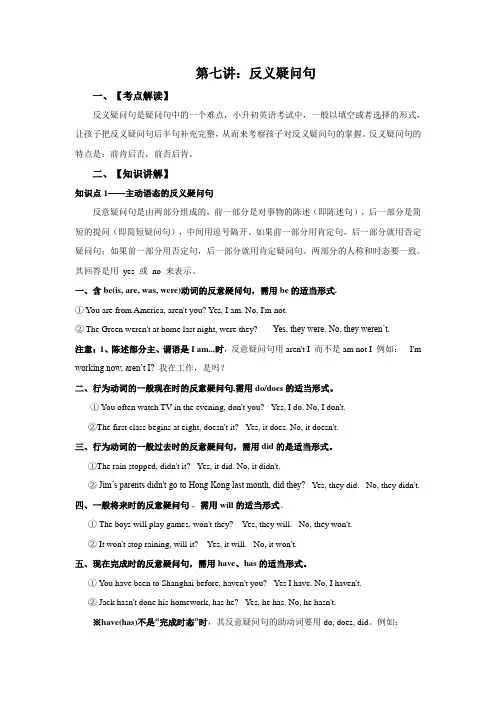
第七讲:反义疑问句一、【考点解读】反义疑问句是疑问句中的一个难点,小升初英语考试中,一般以填空或者选择的形式,让孩子把反义疑问句后半句补充完整,从而来考察孩子对反义疑问句的掌握。
反义疑问句的特点是:前肯后否,前否后肯。
二、【知识讲解】知识点1——主动语态的反义疑问句反意疑问句是由两部分组成的,前一部分是对事物的陈述(即陈述句),后一部分是简短的提问(即简短疑问句),中间用逗号隔开。
如果前一部分用肯定句,后一部分就用否定疑问句;如果前一部分用否定句,后一部分就用肯定疑问句。
两部分的人称和时态要一致。
其回答是用yes 或no 来表示。
一、含be(is, are, was, were)动词的反意疑问句,需用be的适当形式.① You are from America, aren't you? Yes, I am. No, I'm not.② The Green weren't at home last night, were they? Yes, they were. No, they weren’t.注意:1、陈述部分主、谓语是I am...时,反意疑问句用aren't I 而不是am not I 例如:I'm working now, aren’t I? 我在工作,是吗?二、行为动词的一般现在时的反意疑问句,需用do/does的适当形式。
① You often watch TV in the evening, don't you? Yes, I do. No, I don't.②The first class begins at eight, doesn't it? Yes, it does. No, it doesn't.三、行为动词的一般过去时的反意疑问句,需用did的是适当形式。
①The rain stopped, didn't it? Yes, it did. No, it didn't.② Jim’s parents didn't go to Hong Kong last month, did they? Yes, they did. No, they didn't.四、一般将来时的反意疑问句,需用will的适当形式。
第七讲非谓语动词一、改正下列句子中的唯一错误:1.For the whole afternoon they sang and danced happily without think about their schoolwork.【答案】.think→thinking【解析】without为介词,其后接名词、代词或动名词作宾语。
故将think改为thinking。
2.Having something to do on the train,I couldn't help think about the scene of leaving and felt terribly sorry.【答案】.think→thinking【解析】couldn't help doing sth.为固定搭配,意为“情不自禁做某事”,故将think改为thinking。
3.With my eyes filling with tears,I came into Mr. Li's office.【答案】.filling→filled【解析】此处为“with+宾语+宾补”结构,fill与宾语eyes之间是动宾关系,故用过去分词作宾补4.In regard to protect the environment,we have many things to do.【答案】.protect→protecting【解析】in regard to意为“关于……”,其中to是介词,其后接名词或动名词。
故将protect改为protecting 5.Saw the 18 candles burning,I couldn't keep back my tears.【答案】.Saw→Seeing【解析】see在句中作状语,与主语之间存在主动关系,故用现在分词形式。
6.We finally realized it isn't easy to being a teacher .【答案】.being→be【解析】it is+adj.+to do sth.意为“做某事是……的”,it充当形式主语,真正的主语是动词不定式短语,to后加动词原形7.I am interested in your culture and want know more about it.【答案】.在want后加to【解析】want to do sth.为固定搭配,意为“想要做某事”。
第七讲特殊句式PartⅠ真题变式体验1.[2015·湖南高考]________ after talking to two students did I discover that having strong motivation is one of the biggest factors in reaching goals.答案:Only 根据“did I discover"且句子为陈述句可知此处考查倒装句。
“only+状语"位于句首时,引出部分倒装,故答案是only。
2.[2015·江苏高考]It might have saved me some trouble ________ I known the schedule.答案:had 根据句式结构分析,两个句子中无连词,且“I”后的“known”为过去分词,可判断为省去if的虚拟语气引出倒装的情况,主句是与过去相反,从句应为过去完成时,故填had。
3.[2015·重庆高考]Bach died in 1750, but it was not until the early 19th century ________ his musical gift was fully recognized。
答案:that 根据“it was+________+句子”结构去掉“it was”与空格发现句子仍成立。
可知此题考查强调句型,故填that。
4.[2015·湖南高考]Always ________ in mind that your main task is to get his company running smoothly.答案:keep 根据句子结构分析可知,此处考查祈使句,“keep in mind”记住.句意:记住你的主要任务是使他的公司运行顺利。
5.[2014·天津高考]Give me a chance, ________ I'll give you awonderful surprise.答案:and'本题考查特殊句式中的“祈使句+and+陈述句”句式.故填and.句意:给我一次机会,我会给你一个惊喜.6.[2014·福建高考]The climate here is quite pleasant, the temperature rarely,________ ever,reaching 30 ℃in summer。
高考英语3500词第七讲1.bent adj. 弯的n. 爱好,才能【bent是bend(弯曲)的过去式和过去分词bent表示为…而折腰,为…而倾倒,故衍生出名词“爱好、嗜好”之意。
】2.beside prep. 在…旁边; 靠近【来源于古英语be sidan (在...附近)。
】3.besides prep. 除…以外(还有)adv. 此外【来源于古英语be sidan的属格形式( -s是古英语时期的属格词尾)。
】4.betray v. 出卖, 背叛, 泄露(秘密)【bet(赌博) + ray(光线) => 聚众赌博为光线,赌注为光线,大家聚众赌博,结果被人告密、出卖。
谐音:被踹.】5.between prep. 在(两者)之间; 在…中间【前缀be-,强调。
tween,二,词源同two.】6.beyond prep. (表示位置) 在…的那边; 为…所不能及;晚于;超出【前缀be-,强调。
yond,那边】7.bicycle n. 自行车【词根词缀:bi-二 + -cycl-圆 + -e】8.bid v.& n 出价, 投标【bid:必得。
老板下令,这次投标一定要成功,我们志在必得——命令;出价,投标。
】9.big adj. 大的10.bike = bicycle n. 自行车【bike是由bicycle缩略、简化而来。
】11.bill n.账单; 法案, 议案;(美)钞票, 纸币【bill一词始见于14世纪,源自中世纪拉丁语butla的异体bilta。
该拉丁词原义为“图章”、“印记”,后指“盖有图章、印记的公文或法令”,因此bill今天所用的多数词义,诸如“帐单”、“议案”、“钞票”、“单据”、“证明书”等均与此有联系。
带bill的短语,诸如bill of lading(提货单),bill of sale(卖契),bill of health(检疫证书)等均含有“盖有印章的”或“署了名的”的含义。
第七讲名词性从句主语从句1.that引导主语从句时,没有具体意思,不充当句子成分,只是起标志性的作用,但that不能省略。
what引导时,在从句中充当成分,且有意义。
◆It is true that the college will take in more new students.这所大学将招收更多的新生是真的。
2.whether连接主语从句时,表示怀疑,不能省略,意为“是否”,在句首时不能用if替换。
◆(重庆卷)It is still under discussion whether the old bus station should be replaced with a modern hotel or not.旧汽车站是否应该被一个现代化的宾馆取代仍然在商讨中。
3.连接代词、连接副词引导主语从句时不能省略,并在从句中充当句子成分。
◆It was never clear why the man h adn’t reported the accident sooner.这个人为什么没有尽快报告这个事故,还不清楚。
4.主语从句要用陈述语序,即主谓语序。
(1)用it作形式主语的常用句型有:①It+系动词+形容词(necessary/right/likely/unlikely/wrong/important/certain等)+that从句②It+be+名词(短语)(a pity/a shame/no wonder等)+that从句③It+be+过去分词(said/told/reported/decided等)+that从句④It+特殊动词(seems,appears,happens,matters)+that从句◆It is a pity that I missed the party held last night.很遗憾我错过了昨晚举行的聚会。
◆It is reported that the accident was caused by carelessness.据报道,该事故源于(司机的)粗心(驾驶)。